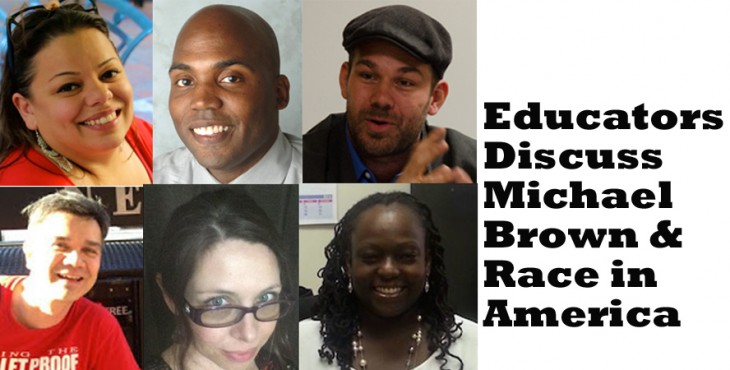by Aixa Rodriguez.
1. In terms of a response to the Michael Brown shooting, what is our responsibility as educators and citizens who care about social justice?
Educators are on the front line when it comes to dealing with the effects of tragic events. When it comes to the Michael Brown shooting the the subsequent protests and militarized police response, teachers who care about social justice, should take this opportunity to discuss this event. It is our responsibility to connect what we teach to real life. How much more real life can this be? The entire nation was glued to the news and live-streams. Those who did not seek out several sources of information from a variety of points of origin ended up not knowing the full picture. It is our responsibility to point out the law, bias, choices made during conflict, not accepting facts without checking them, the bias and agenda of certain news sources etc. We are supposed to help them question their world. This is a good time to discuss feelings, write memoirs, create videos, write and give speeches. I am an ESL teacher and my students come from all over the world and have to navigate the racial tensions in the United States with a whole other understanding and level of experience. They quickly pick up beliefs and attitudes but if they came to the USA in high school, they do not have the frame of reference to understand and interpret the events in Ferguson with the same lenses as those educated here all their lives. This is why these conversations should be had. This is why connections between the present and the past must be built.
2. What are some productive ways to initiate and engage in dialogue with others on issues of racism?
When engaging in dialogue with others on issues of racism be prepared to encounter defensiveness, denial, and strong emotional response. A productive way to engage in self-regulated group conversations that are not facilitated by an outside expert is to use methods that allow all of the people to speak, such as a talking piece and a timer, chart paper, markers, and other writing supplies. It is also helpful to begin with common understandings such as a glossary of terms: racism, privilege, institutional racism, white supremacy, etc. Here is a social justice terminology glossary.
It might be helpful to confront the main issues that create conflict first; definition of racism (prejudice +power), that reverse racism does not exist, what white privilege is and how it is expressed in one’s daily life and manifests itself in educational institutions. Working through these terms and guidelines before open discussion can help everyone have a productive conversation with the same “frame of mind”.
3. What are some pitfalls to avoid?
Pitfalls in conversations cannot always be avoided but attempts can be made. Here’s a list of ground rules The biggest and most important pitfall is allowing anyone to dominate the conversation. The biggest complaint people of color have when having these discussions is being drowned out by white voices who are not listening, but rather are merely waiting for their turn to speak. They are contradicted and irrelevant “facts” are thrown into a conversation to muddy the water and destroy the thread of conversation. Denial and disbelief and “colorblind” attitudes also poison these dialogues. To tell someone that you don’t “see” color is not just ridiculous, but it is actively denying a part of someone’s identity that they cannot change; you are denying and suppressing that persons full value. Simply acting as if race doesn’t matter, or diversity doesn’t matter is avoidance of reality. Assumptions don’t work either. Not every person of color has had the same experiences, so it is best to ask and listen and absorb. Framing conversations with words like tolerance can also set an uncomfortable tone. It is not merely enough to tolerate others, nor is acceptance of others enough, we need to aim for appreciation.
4. Where can these dialogues lead us?
There are those who do not see the value of these conversations for educators but I maintain that they are very important to have. Many decisions are made in educational institutions from hiring, to the books chosen for English classes. Students this past year at my school questioned why there was not one African American teacher on staff. Students notice the absence of people who look like them. Parents notice this too. Diversity matters. What books are chosen for whole class instruction and the books available in classroom libraries matter. Discipline policy and interventions matter. All of these things are impacted by internal bias. The phenomena of the school to prison pipeline has received much discussion of late. Having conversations about how bias impacts how a behavior is viewed, reported and acted on is necessary if we are to stop this pipleline. Having these conversations allows each teacher to reflect on their own biases and be more conscious of what they teach, to whom they teach it and why its valuable.
Aixa Rodriguez was Born and raised in the Bronx. She received a bachelors degree from Fordham University in 2000, and Fordham University Graduate School of Education ’05. She is an ESL Teacher.





szemelman
Again, I want to say that when misconceptions come up in conversations on race (and other forms of prejudice, like sexism), some of the best solutions I’ve seen have been for the teacher to say, “OK, let’s research this and find out what’s true” — rather than just go back & forth. Randy & Catherine Bomer describe this beautifully in “For a Better World: Reading and Writing for Social Action.”
And on the question, “Where can these dialogues lead us?” — An empowering answer is: “To students’ action.” Students who embark on this find their outlook changed, their sense of identity strengthened — and they learn academic skills and knowledge as well.
–Steve Zemelman